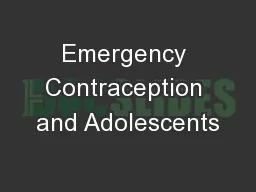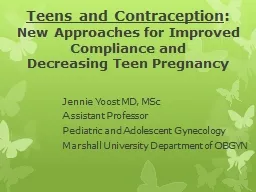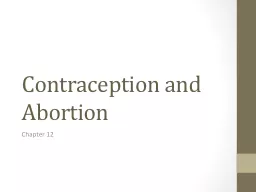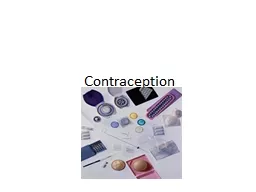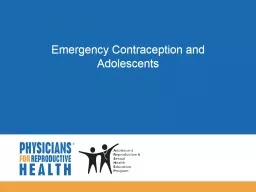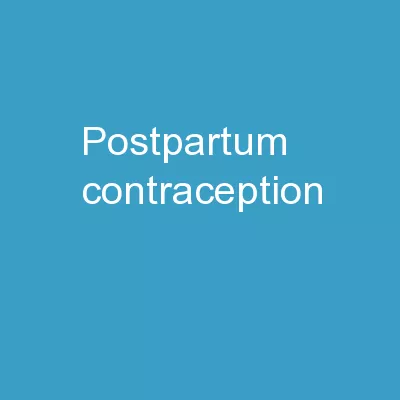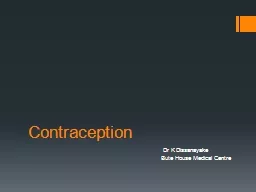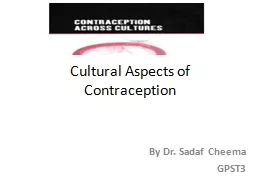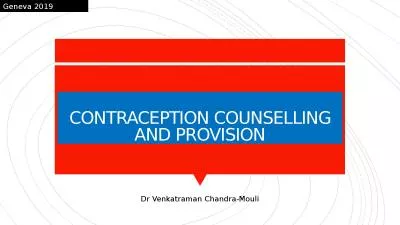PPT-Contraception in Adolescents
Author : tawny-fly | Published Date : 2020-04-03
Allison Eliscu MD FAAP Rev Aug 2012 Contraception in Adolescents Oral Contraceptive Male Condom IUD NuvaRing Birth Control Patch Female Condom Depo Provera The
Presentation Embed Code
Download Presentation
Download Presentation The PPT/PDF document " Contraception in Adolescents" is the property of its rightful owner. Permission is granted to download and print the materials on this website for personal, non-commercial use only, and to display it on your personal computer provided you do not modify the materials and that you retain all copyright notices contained in the materials. By downloading content from our website, you accept the terms of this agreement.
Contraception in Adolescents: Transcript
Allison Eliscu MD FAAP Rev Aug 2012 Contraception in Adolescents Oral Contraceptive Male Condom IUD NuvaRing Birth Control Patch Female Condom Depo Provera The Importance of Contraception in Adolescence. David Hubacher, PhD. Senior Epidemiologist. FHI. Outline of Talk. Description of long-acting reversible contraception (LARC). Worldwide use of long-acting. Advantages and Disadvantages. Service delivery factors. Objectives. Discuss the need for emergency contraception (EC) among adolescents. Describe the clinical components of EC. Understand the challenges and opportunities for increasing EC use at the patient, provider, and health systems level. What can happen if you have unprotected sex?. . Pregnancy . Sexually Transmitted Infections (STIs) . Pregnancy. Pregnancy Intention vs. Behavior. Sexually Transmitted Infections (STIs) . Methods of Protection. What You Need to Know. Jennifer Cannon, NP-C. Adult Cystic Fibrosis, Stanford Health Care. March 13, 2016. Overview. Contraception. Importance of Contraceptive Education. Current Research: Contraception in Cystic Fibrosis Patients. : . New Approaches for Improved Compliance and. Decreasing Teen Pregnancy. Jennie . Yoost. MD, MSc. Assistant Professor. Pediatric and Adolescent Gynecology. Marshall University Department of OBGYN. Chapter 12. Learning Objectives. Contraception. Contraception in the US: The political battle. Methods of Contraception. Abortion. Perspectives on Abortion. Methods of Abortion. Contraception. Contraception in US: The Legal Battle. UNC School of Medicine. Obstetrics and Gynecology Clerkship. Case Based Seminar Series. Objectives for Contraception and Sterilization . Describe the mechanism of action and effectiveness of contraceptive methods. 3.3 million pregnancies are unplanned each year. North Carolina featured 50-56 per 1000 in 2008. We all know someone who had an unplanned pregnancy many times these are teen agers when this occurred.. What You Need to Know. Jennifer Cannon, NP-C. Adult Cystic Fibrosis, Stanford Health Care. March 13, 2016. Overview. Contraception. Importance of Contraceptive Education. Current Research: Contraception in Cystic Fibrosis Patients. Objectives. Discuss the need for emergency contraception (EC) among adolescents. Describe the clinical components of EC. Understand the challenges and opportunities for increasing EC use at the patient, provider, and health systems level. Anita . L. Nelson, MD. Harbor-UCLA Medical . Center. Contemporary Forums . Conflict of Interest Disclosure. Anita L. Nelson, MD. Grants/. Research. Bayer, Merck, Pfizer, Teva. Honoraria/. Speakers Bureau. Dr. K Dissanayake. Bute. House Medical Centre. Different Methods. Hormonal. Barrier methods. IUD. Natural methods. Sterilisation. Things to consider. Age, consider whether Fraser competent in <16 . . By Dr. Sadaf Cheema . GPST3 . Aims:. Awareness of ethical issues related to contraception. Cultural Values . Cultural . isolation. Population . migration. Religion. Migration-Unmet need for contraception . Geneva 2019. Dr Venkatraman Chandra-Mouli. DEFINITION. Contraception is the intentional prevention of pregnancy by artificial or natural means.. It enables people to attain their desired number of children, & to determine the spacing of their pregnancies by delaying or preventing child bearing..
Download Document
Here is the link to download the presentation.
" Contraception in Adolescents"The content belongs to its owner. You may download and print it for personal use, without modification, and keep all copyright notices. By downloading, you agree to these terms.
Related Documents


